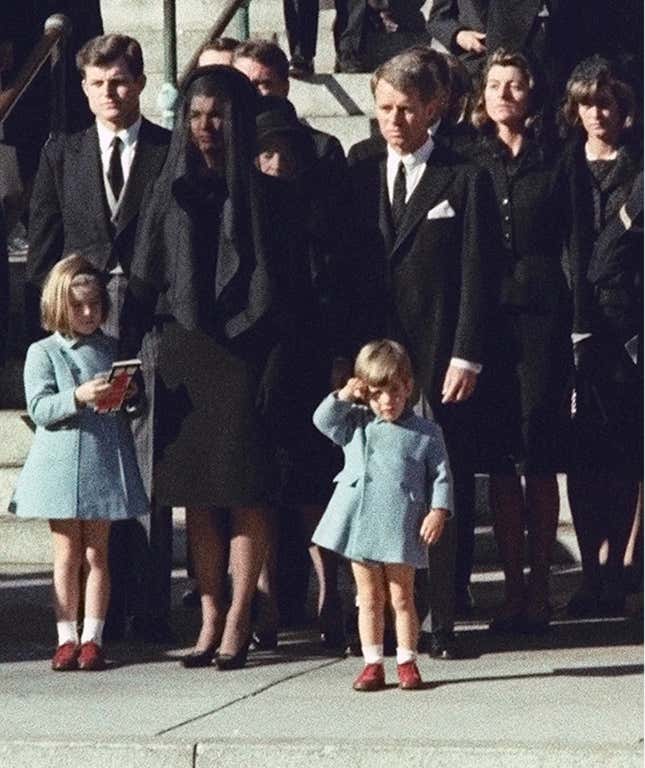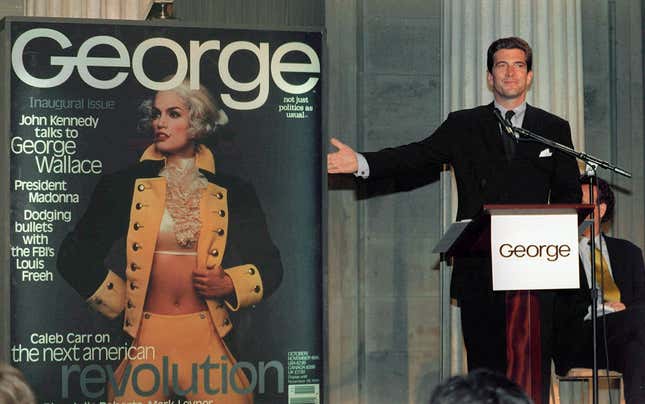CHARMED LIFE, TRAGIC DEATH: JFK Jr. and the Last of the Great Magazine-Made Men
In Depth
Illustration: Elena Scotti
John F. Kennedy Jr. died young; whatever his promise, he never achieved it. He wasn’t a popular politician, or a successful actor, or a musician with a closet full of Grammys. And yet, his death two decades ago prompted wall-to-wall media coverage, absolutely dominating the news cycle for days upon days.
Kennedy died 20 years ago this week, in a plane crash off Martha’s Vineyard with his wife Carolyn Bessette Kennedy and her sister Lauren. It was a perfect media story, an instant narrative arc. After decades cast as a hunky heir to a great dynastic legacy, Kennedy died young, headed to a WASPy summer destination. There was even an element of classic Aristotelean tragedy, since the accident was likely due to the fact that Kennedy chose to fly without an instructor, despite being inexperienced flying on instruments, meaning when the weather quickly deteriorated he didn’t have the skills to get safely to the ground.

Kennedy’s death was perhaps the last great celebrity story of its era, triggering a flood of covers on magazines from Newsweek to Time to People, as well as a slew of commemorative magazines, full of tributes to a man positioned as an American prince. The August 2, 1999 cover of People said it all: “CHARMED LIFE, TRAGIC DEATH.” It was the end of an era, but not in the way that the money-minting, blockbuster popular People realized. It was a high water mark for celebrity magazines’ place in the world, and for an entire model of celebrity.
A highly specific set of circumstances, both cultural and chronological, combined to make JFK Jr as famous as he was, but it’s impossible to separate his anointed place in American culture from the media that so loved him, especially magazines. The internet has completely transformed the way we consume information, so it’s easy to forget the power of general-interest magazines, like Time and Life, during the midcentury—and the Kennedy family looked very, very good in those pages. First, there was his childhood as “John John,” the adorable toddler of a young, photogenic president; his place in the national consciousness was cemented by the famous shot of Kennedy saluting his father’s casket. The image would follow him for the rest of his life, even as he repeatedly reminded everyone who asked him that he had no memory of the moment, because he was three years old.

As his mother transformed from the horribly widowed First Lady to the celebrity Jackie O, of the giant sunglasses and Greek magnate husband, her son, too, entered adulthood as the anointed star of a new era of celebrity coverage. In 1974, just as Kennedy entering his teens, People launched with the explicit goal of focusing on the real lives and personalities of the rich and famous, his friend Steven M. Gillon points out in a new biography, America’s Reluctant Prince. Kennedy was perfect subject matter. He aged into a perfect storm: print newsweeklies and tabloids existed together at the height of their influence, with Kennedy a rare crossover figure—heir to a political dynasty with the seriousness for Time, but also an objectively hot, athletic Manhattan bachelor, perfect fodder for the pages of People.
Not long after, in 1977, one of his hometown tabloids, The New York Post, would launch Page Six, their famed gossip section. Both would cover Kennedy, with the dedication that some outlets would show the president. In 1988, he was the fourth person named People’s “Sexiest Man Alive,” birthing a lead that is among the thirstiest words ever committed to newsprint:
Okay, ladies, this one’s for you—but first some ground rules. GET YOUR EYES OFF THAT MAN’S CHEST! He’s a serious fellow. Third-year law student. Active with charities. Scion of the most charismatic family in American politics and heir to its most famous name.
Get your eyes off that man’s extraordinarily defined thighs! What do you think, he strips down to his shorts for a game of touch football in Central Park so strangers can gape at them? They are fantastic, though. Measure three, four feet around. Legend has it that if he lived in Tahiti, instead of Manhattan, he could crack coconuts with them.
It was a one-two punch: the political legacy, and the fact that the man was legitimately extremely attractive.
We’ve got plenty of borderline aristocrats already, and despite their best efforts, they’re struggling to sell the image of goodhearted noblesse oblige.
Then, as Kennedy was casting around for something to do that wasn’t immediately entering politics, a friend proposed a perfect idea for a man who’d spent his entire life gracing glossy pages: George, a magazine with a mission to treat politics as popular culture. According to Gillon, the cofounders partnered with the magazine company Hachette, and when they arrived, they discovered that the company actually wanted something more like People, using Kennedy to get cozy access to celebrities and powerful politicians and revolving around Kennedy’s persona and life—a notion that Kennedy immediately and firmly rejected, but the tension over the magazine’s identity was never entirely resolved.

Such sheer media dominance fades very slowly. The New York Post, which followed Kennedy’s life closely, is still skulking around the University of Michigan, trying to get any information they can about the life of Carolyn Bessette Kennedy’s remaining sister, despite her very clear lack of appetite for the spotlight.
But the anniversary of Kennedy’s death drives home the degree to which the mechanisms of celebrity have shifted. We live in the era of the micro-celebrity, the influencer. In her new book, The Drama of Celebrity, Sharon Marcus argues that the internet has driven celebrity back to its “anarchic” origins: “Today, the fact that no single medium or industry controls stars or stardom has made more visible how strongly publics and celebrities have always influenced the course of celebrity culture and how their moves have been crucial to keeping it alive.”
Kennedy’s death was maybe the last great event of the old model, before the rise of Perez Hilton and celebrity blogs shifted power away from their institutional predecessors in print. When Kennedy died, the commemorative magazine still reigned; fans participated in their grief by consuming media, not creating it; and, if they felt really compelled, going in person to lay flowers on some sort of ad hoc memorial. I recently encountered a photo from the news coverage of the one-year anniversary of the crash—a picture of two women on the beach, reading an issue of People dedicated to Kennedy’s untimely death. A picture of people reading magazines: that summed up the event. Now, the model intrinsically more participatory. The model is Twitter.
Now, the model intrinsically more participatory. The model is Twitter.
But this is likely the last big anniversary where Kennedy will warrant a huge media blitz. Princess Diana, the other great celebrity of the era lost suddenly, shockingly to a terrible accident, will remain in the public consciousness because of the ongoing story of her children—the consequence of being literal royalty instead of a media-built monarch.
The famous Kennedy mystique, on the other hand, is dissipating, as the supposed glory days of “Camelot” fade further and further into the distance and the baby boomers are succeeded by several generations in a row whose lives are dominated not by postwar plenty, but a growing sense of scarcity and uncertainty. The gap between the haves and the have-nots is widening, and no one cares about anointing a new American prince. We’ve got plenty of borderline aristocrats already, and despite their best efforts, they’re struggling to sell the image of goodhearted noblesse oblige.
You can divide history any number of ways: chronologically, ascribing a character to various decades and centuries, or thematically, carving years into eras. One way of seeing the 20th century is to sum it up as the magazine century, and by that metric, Kennedy’s death—not New Year’s Eve, not the bursting of the dot-com bubble, and not 9/11—is its end. In the bottom left-hand cover of the People magazine devoted to Kennedy’s death, under the barcode, there’s a note: “AOL Keyword: People.” Sometimes you don’t see an era ending until it’s already gone.